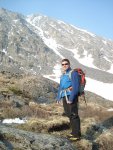I am looking for workouts that prepare you for long climbs with steep ascents. I attempted Mt Saint Helens, and I was pretty tired going through the rocks above 4800'. I ended up turning around at 6200'ish feet which is about 2,100' before the summit. I could see it, but I was low on water. Brought 2L of water and a gatorade. My bladder was basically empty when I returned to the parking lot.
I have done other 800-1200' per mile elevation gain hikes before without being this tired, but generally I am carrying less weight (no spikes, ice axe, extra layers, gps, compass, etc) and the elevation usually tops out around 4500-5000' for most hikes.
A workout that mostly incorporates bodyweight would be good. My weight set is basically a 45lbs barbell, 45's, 25's, 10's, and a 25lbs kettle bell.
My goal is to reach Camp Muir on Mt Rainier and maybe Mt Adams this summer if I can get in a class on glacier travel. I will save another Helens attempt for later in the fall when more snow gets back on the mountain.
I have done other 800-1200' per mile elevation gain hikes before without being this tired, but generally I am carrying less weight (no spikes, ice axe, extra layers, gps, compass, etc) and the elevation usually tops out around 4500-5000' for most hikes.
A workout that mostly incorporates bodyweight would be good. My weight set is basically a 45lbs barbell, 45's, 25's, 10's, and a 25lbs kettle bell.
My goal is to reach Camp Muir on Mt Rainier and maybe Mt Adams this summer if I can get in a class on glacier travel. I will save another Helens attempt for later in the fall when more snow gets back on the mountain.


